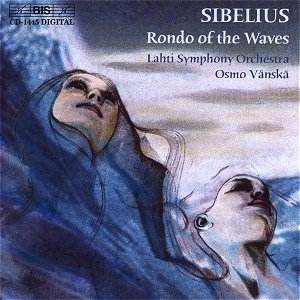Hardcore Sibelians will need no second bidding.
In fact they will have bought this CD long before reading this
review. They are most unlikely to be disappointed for this disc
contains some vintage Sibelius.
The Oceanides in its various stages of
evolution forms the core of this selection. It appears in three
forms. For Sibelius enthusiasts this will be the main draw although
completists (to whom the Bis Sibelius Edition inevitably appeals)
will have many pleasurable surprises before the disc is played
right through.
The place of The Oceanides' in the Sibelius
catalogue has been peripheral. The starker minimalist corner holds
The Bard and Luonnotar. The warmer realms are inhabited
by Nightride and Sunrise, itself an echo of Nielsen's
Mediterranean sunrise in the overture Helios, and The
Oceanides. The front rank of the tone poems is occupied by
En Saga, Pohjola's Daughter and Finlandia,
all of which have attracted many recordings.
The Oceanides was never recorded
by Kajanus or Schneevoight. It fell to Beecham (EMI) and Boult
(1950s, Omega Classics OCD 1028) to establish a performing tradition
on disc. The Beecham has held its place rather well, usually coupled
with his final and rather languidly indulgent Seventh Symphony.
In the early 1970s Antal Dorati recorded the work for EMI Classics.
Boult's 1956 mono version with the LPO is nervy and tetchy but
shows its age both in the high volume of hiss and in the unsophisticated
ADD sound. Better still is Sinaïski's version with the Moscow
Philharmonic in 1991. This is outstanding for the rampant feral
tempest achieved at 7.50. Simon Rattle’s EMI version with the
CBSO is highly thought of. The Bis recording of the final version
of the tone poem is from BIS-CD-1225, issued in 2002. It is the
best recording I have heard, resplendent in subtle hues, rich
in allusion and silky in string sound whether solos or in full
spate. The gentle dialogue at 06.48 is a good example of Vänskä's
and Bis's non-obvious approach. Vänskä literally plays
up a storm straight out of Tapiola at 8.48 though missing
by a hair the smashing power expressed by Sinaïski on his
Harmonia Mundi version (the complete Sibelius tone poems LDC 288
105/107).
The Yale version of The Oceanides is
the second stage, just prior to the evolution of the piece into
the tone poem we now know. It was written at the commission of
Carl Stoeckel for the Norfolk Festival. Some of the themes and
treatments are familiar from the final edit but here they often
go off in new directions. There is also fresh material: lush harp
sweeps from Luonnotar, romantic yearning from the Second
Symphony, shrills and shudders from Tapiola. Coming to
it afresh you should approach this, not in the spirit of study
but simply appreciate it as a 'new' Sibelius tone poem with its
own identity using some material familiar from The Oceanides.
What a title it once enjoyed: Rondo of the Waves! A shame
it was cast aside.
You can also hear two movements of a three
part suite which seems to have been the first stage in the
genesis of The Oceanides. While Aallottaret (i.e.
the Yale version) is a completely earnest and very beautiful piece,
this suite is predominantly lighter. It is extremely graceful
in both tr. 2 (tempo moderato) and tr. 3 (Allegro)
and is akin to the best of Sibelius's theatre music.
Cassazione begins stern, relentlessly
insistent, ferocious and triple forte - quite the antithesis of
the title. I wonder, did John Barry see the score for this before
writing the more threateningly peremptory and inimical Bond music.
The piece remains pretty uniformly serious. This is a surprising
work and certainly not the sort of light Sibelius we hear in the
various late string suites. There is even a Balakirev-style clarinet
solo at 4.50, an Elgarian serenade at 7.02 and a chaste oboe solo
at 10.37. The piece is played and recorded with wit, rapacious
energy and gripping concentration. Sibelius must have had a sense
of humour to call this work a ‘cassation’. It is more of a Ballade
for orchestra. Serious Sibelians need to hear this.
Musik zu Einer Scène was
written for a tableau so its filmic Tchaikovskian qualities should
not surprise. Here, quite apart from the later lighter moments,
with much work for flute and tambourine, Sibelius looks back to
the first two symphonies. The piece ends as rainheavy storm clouds
gather and thunder rumbles.
The Coronation March was originally
part of the 1896 cantata for the Coronation of Nicholas II. It
is heavy with atmosphere but elusive in subject matter. Not another
Pomp and Circumstance to be sure.
Morceau Romantique has a voluptuous
Spanish atmosphere with the odd nod toward Tchaikovsky. The
March of the Pori Regiment is the leading march of the
Finnish armed forces. The melody is not Sibelius's. It is an exercise
in noisy braggadoccio and repetitive gesture. The Cortège
starts well with a stern fanfare reminiscent of the trumpets in
Tchaikovsky's Capriccio Italien. A nicely turned characteristic
Sibelian melody written with some tribute to Tchaikovsky surely
in mind, is underpinned by an ‘oompah’ brass ostinato. The 1895
version of Spring Song is as impressive as Cassazione.
This is the Sibelius of Lemminkainen and the Maidens
of Saari (6.32; 8.43). Here the mass strings dominate. Climactic
moments suggest a hybrid of Miaskovsky and Tchaikovsky in the
deliberately paced yet taut-as-a-drum string passages which predominate.
Superbly documented and engineered. Exalted interpretative
values and rare vintage Sibelius. For those who must have their
Sibelius 'fix' here is a mix of barrel scrapings and substantial
discoveries: Cassazione, Aallottaret and Spring
Song as well as an outstanding recording of The Oceanides.
Rob Barnett
